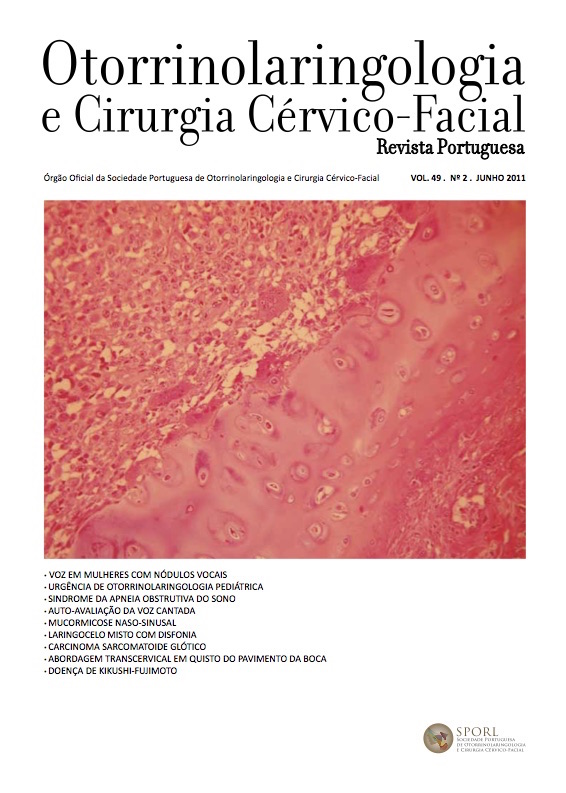Obstructive sleep apnea syndrome: Nine years experience
DOI:
https://doi.org/10.34631/sporl.162Keywords:
Obstructive Sleep Apnea Syndrome, uvulopalatopharyngoplastyAbstract
Obstructive Sleep Apnea Syndrome (OSAS) is estimated to affect 2-4% of the population. There is an imbalance between the forces dilating and occluding the pharynx during sleep time.
Objective: Evaluation of epidemiological data, signs and symptoms, upper-airway evaluation, non-surgical and surgical treatment of OSAS.
Material and methodology: Retrospective study of clinical processes from all patients diagnosed with obstructive sleep apnea at the Centro Hospitalar do Alto Ave in the period from February 2001 to February 2010.
Results: A series of 459 patients were included. There was a male predominance. 63,3% of patients using CPAP (Continuous Positive Airway Pressure) were considered as adapted? 139 surgeries were performed, mostly uvulopalatopharyngoplasties, which were successful in 57.78% of patients. The best results were achieved in patients with low body mass and apnea/hipopnea indexes .
Downloads
References
Fernandes FS, Lousan NC, Matos CA, Curso teórico prático Roncopatia e SAOS: do diagnóstico à terapêutica. Abstract XV Congresso de Otorrinolaringologia e Cirurgia Cérvico-Facial
Findley LJ, Unverzagt LE, Surrat PM. Automobile accident involving patients with obstructive sleep apnea. Am Rev Respir Dis 1988 ; 138 : 337-340
Rubins JB, Kunisaki KM., Contemporary issues in the diagnosis and treatment of obstructive sleep apnea., Postgrad Med. 2008 Jul;120(2):46-52. Review
Walter T. McNicholas , Diagnosis of Obstructive Sleep Apnea in Adults, The Proceedings of the American Thoracic Society 5:154-160 (2008)
Martins AB, Tufik S, Moura SM., Physiopathology of obstructive sleep apneahypopnea syndrome, J Bras Pneumol. 2007 Feb;33(1):93-100.
Antczak J, Horn B, Richter A, Jernajczyk W, Bodenschatz R, W Schmidt EW., The influence of obesity on sleep quality in male sleep apnea patients before and during therapy, J Physiol Pharmacol. 2008 Dec;59 Suppl 6:123-34
Tasali E, Ip MS. ,Obstructive sleep apnea and metabolic syndrome: alterations in glucose metabolism and inflammation. Proc Am Thorac Soc. 2008 Feb 15;5(2):207-17.
Guilleminault C, Riley RW, Powell NB. Obstructive sleep apnea and abnormal cephalometric measurements. Implications for treatment. Chest 1984; 86 :793-794
Rubins JB, Kunisaki KM, Contemporary issues in the diagnosis and treatment of obstructive sleep apnea, Postgrad Med. 2008 Jul;120(2):46-52.
McDaid C . Continuous positive airway pressure devices for the treatment of obstructive sleep apnoea-hypopnoea syndrome: a systematic review and economic analysis, Health Technol Assess. 2009 Jan;13(4):iii-iv, xi-xiv, 1-119, 143-274.
Meyer B, Chabolle F, Chouard CH. Les traitements chirurgicaux de la rhonchopathie chronique. Description et indications. Ann Otolaryngol Chir Cervicofac 1988 ; 105 : 277-282
Fujita S, Conway W, Zorick F. Evaluation of the effectiveness of uvulopalatopharyngoplasty. Laryngoscope 1985 ; 95 : 70-74
Hudgel DW., Treatment of obstructive sleep apnea. A review, Chest. 1996 May;109(5):1346-58.
http://www.spd.pt/index.php?option=com_content&task=view&id=223
Lacerda Nobre E, Jorge Z., Macedo J., Jácome J, Tendências do peso em Portugal no final do século XX, Acta Med Port 2004; 17 205-209






